Should You Be Worried About Shrink? 34% of SMB Retailers Say It's On the Rise
In 2021, retail industry analysts and big-box retailers began raising the alarm on a purported rise in organized retail crime that had sent shrink—the loss of inventory through theft, damage, and other causes—skyrocketing at stores nationwide. Critics were quick to question both the impact of rising shrink on corporate bottom lines and the prevalence of sophisticated retail theft rings. The difficult truth is that even widely-cited figures on retail shrink rely on data that is all too often misreported, underreported, confusing to capture in the first place, and sourced from limited sample sizes.
Despite how tricky it is to understand and calculate shrink, it’s a metric small businesses need to keep an eye on in order to prevent losses and reveal weaknesses in their supply chains, store operations, and even employee training methods. According to Software Advice’s recent research* on more than 400 retailers, shrink is indeed a growing problem for small to midsize retail businesses. In fact, 34% of SMB retailers report a rise in shrink over the past 12 months, and 46% have experienced more theft at their stores. What’s more, the majority say their shrink rate surpasses the retail industry standard.
With the average shrink rate for SMBs hovering beyond the upper edge of normal, small retailers should keep a close eye out for a sharp increase at their companies, and take proactive steps before shrink gets out of control.
Key insights
68% of SMB retailers have shrink rates currently above the industry standard rate of 1.5%.
46% of small to midsize retailers say external theft has increased in their stores.
Retailers who say shrink has increased tend to operate a large portfolio of physical stores (20 or more).
88% of retail SMBs say preventing retail shrink is a top priority.
Retailers use a variety of loss prevention techniques including security cameras, anti-theft store design, and greeting every customer who enters their stores.
Retail shrink has risen for some small retailers, mostly from theft
Earlier this year, big-box retailers sounded the alarm on the growing problem of shrink, blaming poor quarterly earnings reports on an alleged rise in theft fueled by inflation and the pandemic. [1]
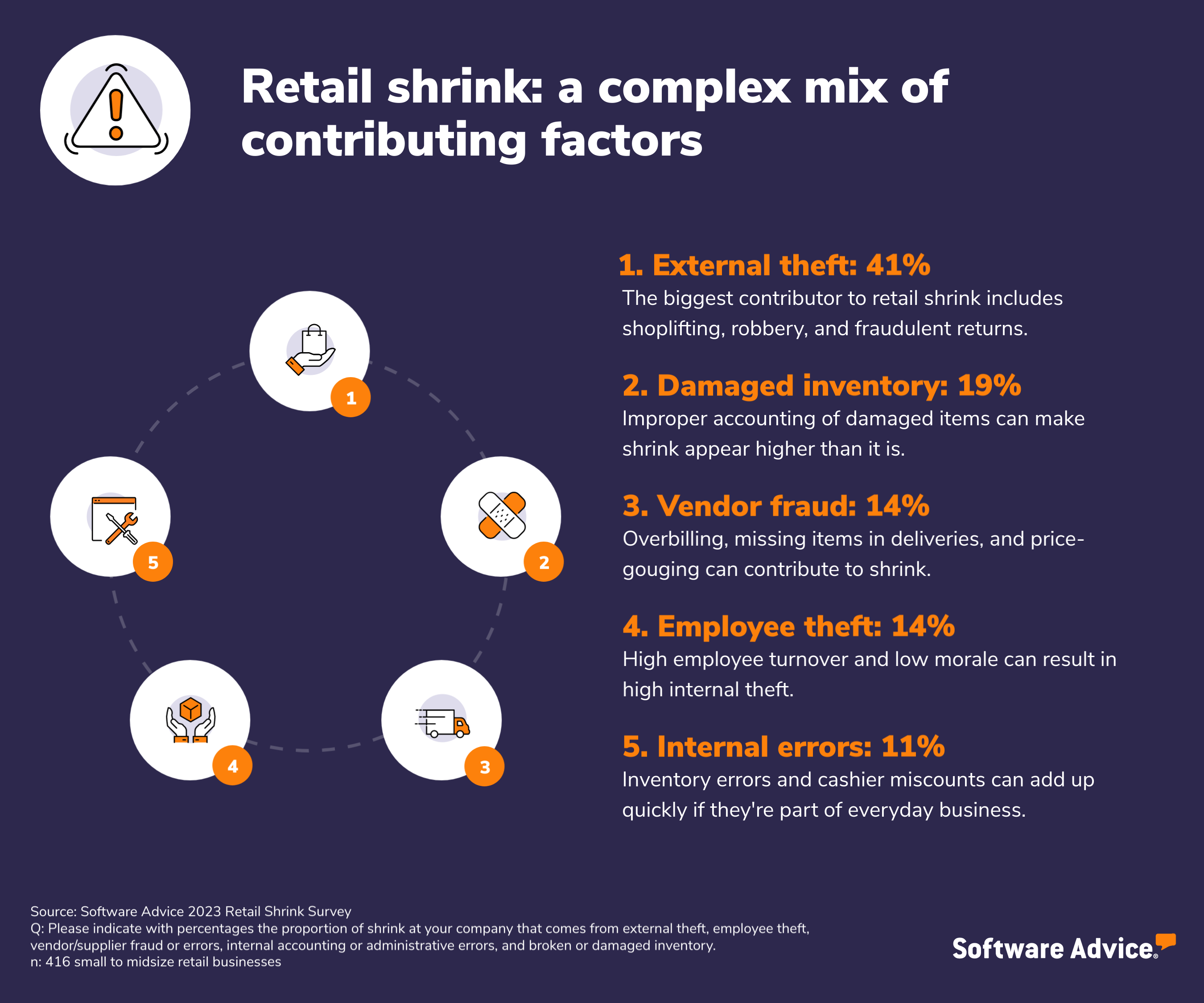
A retailer’s overall amount of shrink comes from a variety of contributing factors, and it’s a part of doing business. Even in a normal year, big brands can expect to lose millions of dollars in potential revenue to theft, errors, and damage.
Shrink is expressed as a percentage of total revenue, with the industry-standard rate hovering around 1.5%. [2] When shrink rises in tandem with revenue over the course of months or years, the rate of shrink may not noticeably change, and contributing factors could be harder to detect and prioritize. But when shrink outpaces revenue, the shrink rate rises, spotlighting an issue that needs immediate attention.
Further investigation into big brands’ recent claims about rising shrink showed that some had exaggerated the impact of shrink—particularly through organized crime—on their bottom lines, when in fact their shrink rates had stayed relatively stable or even declined. [3] While those large brands had experienced significant quarterly losses, the culprit was not exclusively smash-and-grab robberies or sophisticated employee theft schemes.
Furthermore, an estimate that organized retail crime accounted for almost half of the nearly $100 billion lost to shrink in 2021 was found to have been shockingly overblown and based on inaccurate data. [4]
Nevertheless, the recent rise in shrink in the retail industry—though proportionately small for large retailers—is real and has had an outsized effect on SMBs, which operate on narrower margins.
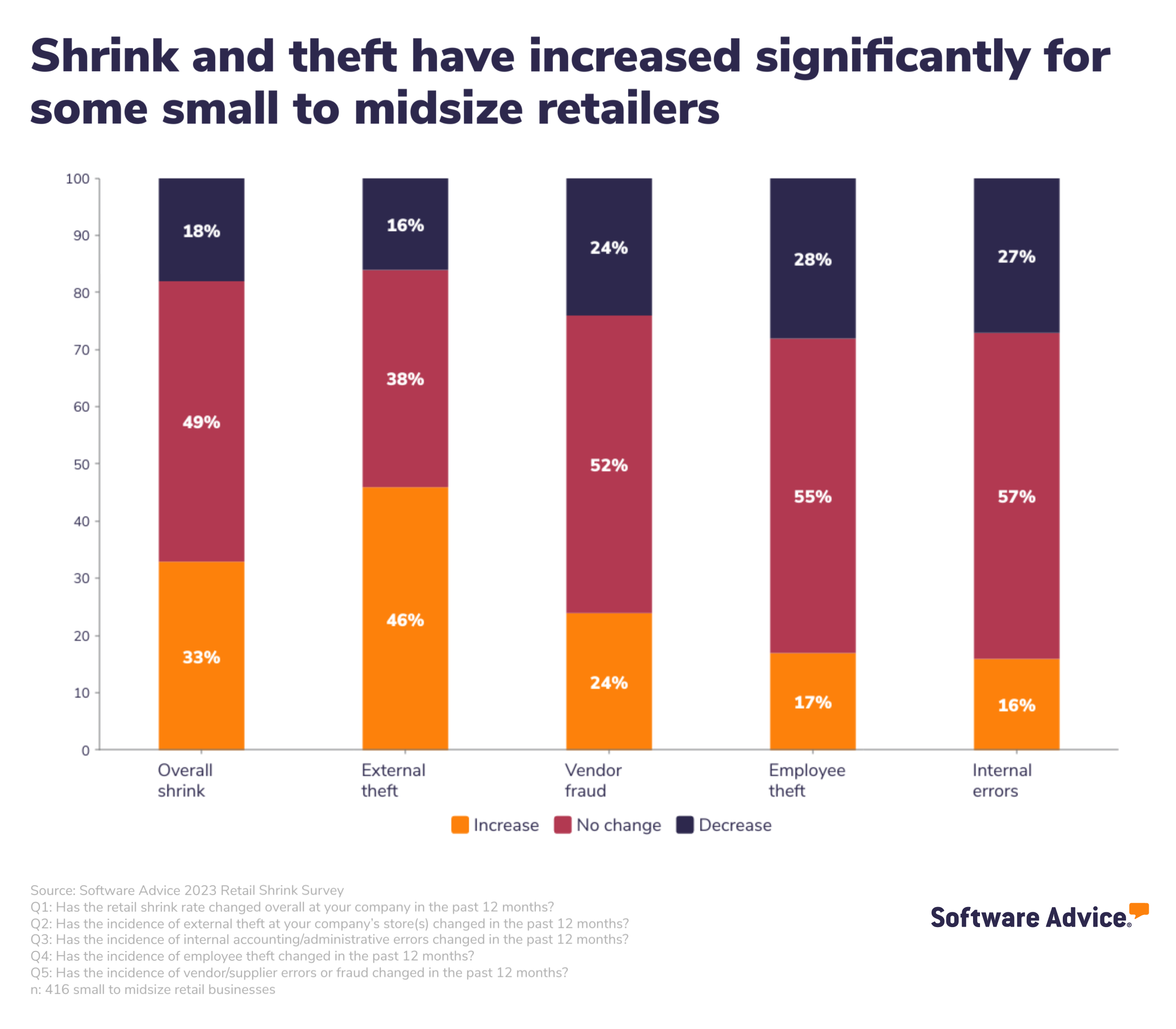
Software Advice’s 2023 Retail Shrink Survey* shows shrink as a percentage of sales has increased for over one-third of small to midsize retailers in the past year. Not only is overall shrink rising, but for SMBs, it’s now taking a larger bite out of revenue. For almost half of small retailers (46%), the rise is coming from external theft, highlighting the expedient need for more effective loss prevention strategies and implementation.
Theft committed by employees, damaged inventory, vendor fraud, and internal errors in accounting or administrative processes make up smaller slices of a SMB’s overall shrink, though each may still represent significant losses.
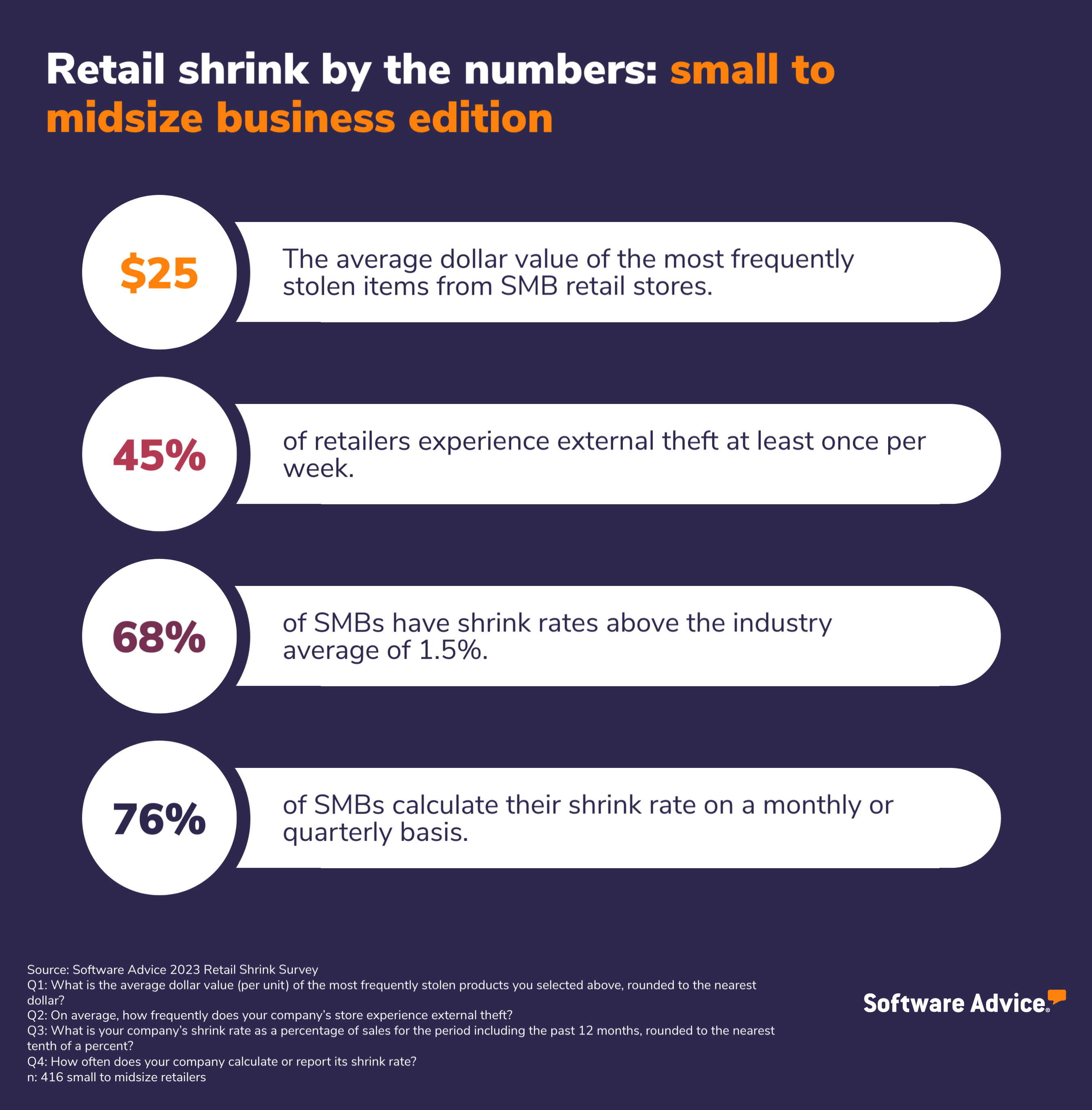
Shrink in these areas can also indicate a larger problem with loss prevention and accountability: Businesses reporting a year-over-year increase in overall shrink are significantly more likely to have noticed increases in all types of shrink, not just external theft. Businesses experiencing a rise in shrink need to take a holistic look at their operations to determine how to reverse the trend.
Why are shrink rates changing for SMBs?
Despite what large retailers claim, the issue of rising shrink isn’t reserved to urban, coastal cities experiencing higher-than-normal rates of smash-and-grab robberies. [5] It has risen for all kinds of retailers—across specialties, geographic regions, and annual earnings.
It’s not always immediately clear why shrink changes for a given company, making it difficult to know where to start with a solution. For example, respondents in this survey point to a variety of possible causes for changes in their shrink rate, both positive and negative:
The economy:
68% of retailers reporting a rise in shrink also cite an increase in external theft; many blame the worsening economy as a key driver, with inflation and the increased cost of living spurring more theft.
The job market:
Some SMBs have hired inexperienced admin staff who make an increasing amount of errors as they get up to speed in their new roles.
Others blame high employee turnover for an uptick in employee theft.
Improvements to security and reporting processes:
Many SMBs have recently increased in-store security measures to monitor and discourage theft. For instance, 54% installed or updated security cameras in their stores within the past year—a surveillance strategy that could uncover previously unobserved instances of theft.
Others hired new management who introduced inventory management, reporting, and training techniques that reduce shrink.
There is one factor that makes a meaningful difference in whether shrink could affect your company: Retailers citing a rise in shrink are significantly more likely to operate larger portfolios of 20 or more physical stores than those with stable or decreasing shrink. Being more exposed to the public increases the risk of shrink, particularly through external theft.
That said, preventing shrink is a top priority for the vast majority (88%) of SMB retailers. Before you panic over a rise in shrink—or celebrate a decrease—at your business, you should look more closely at what the numbers might mean.
Has the shrink rate changed at your business in the past year?
It could be because:
You experienced more theft, fraud, errors, or damage.
You improved shrink reporting processes and identified previously unreported instances of shrink.
You hired new employees who made more errors as they onboarded.
You improved security or loss prevention solutions in your stores and deterred theft that previously would have occurred.
It’s tricky, but taking a deep dive on why your business is dealing with more losses is key to avoiding a potentially expensive reaction. Don’t forget that an overall rise in shrink often comes from multiple sources—you’ll need to investigate potential root causes across different areas of your business.
How to prevent shrink while keeping customers happy
If you’ve noticed a rise in shrink at your business, you want to act quickly to contain the impact. Before you adopt any harsh new policies that could impact your customers and employees, take a moment to stop and think about why shrink is happening and where it’s coming from.
Consider all potential sources of shrink
Don’t just focus on external theft, though that may be a good place to start. Become an expert on how shrink affects your company—which products are most frequently stolen, which employees are on shift when errors occur, which vendors have caused issues, why and how products are returned or damaged—and you’ll be closer to finding the right solution.
Put shrink into context if you’ve made any recent changes—opening or closing stores, hiring new employees, or experiencing a natural disaster can all contribute to a rise in shrink that won’t necessarily repeat itself next year.
Try low-cost methods to reduce external theft
Cutting down on shrink could be as simple as training store employees to pay more attention to store activity or rearranging your store layout to position often-stolen merchandise in highly visible areas.
Currently, most SMBs use a variety of loss prevention techniques to cut down on external theft, and many are inexpensive.
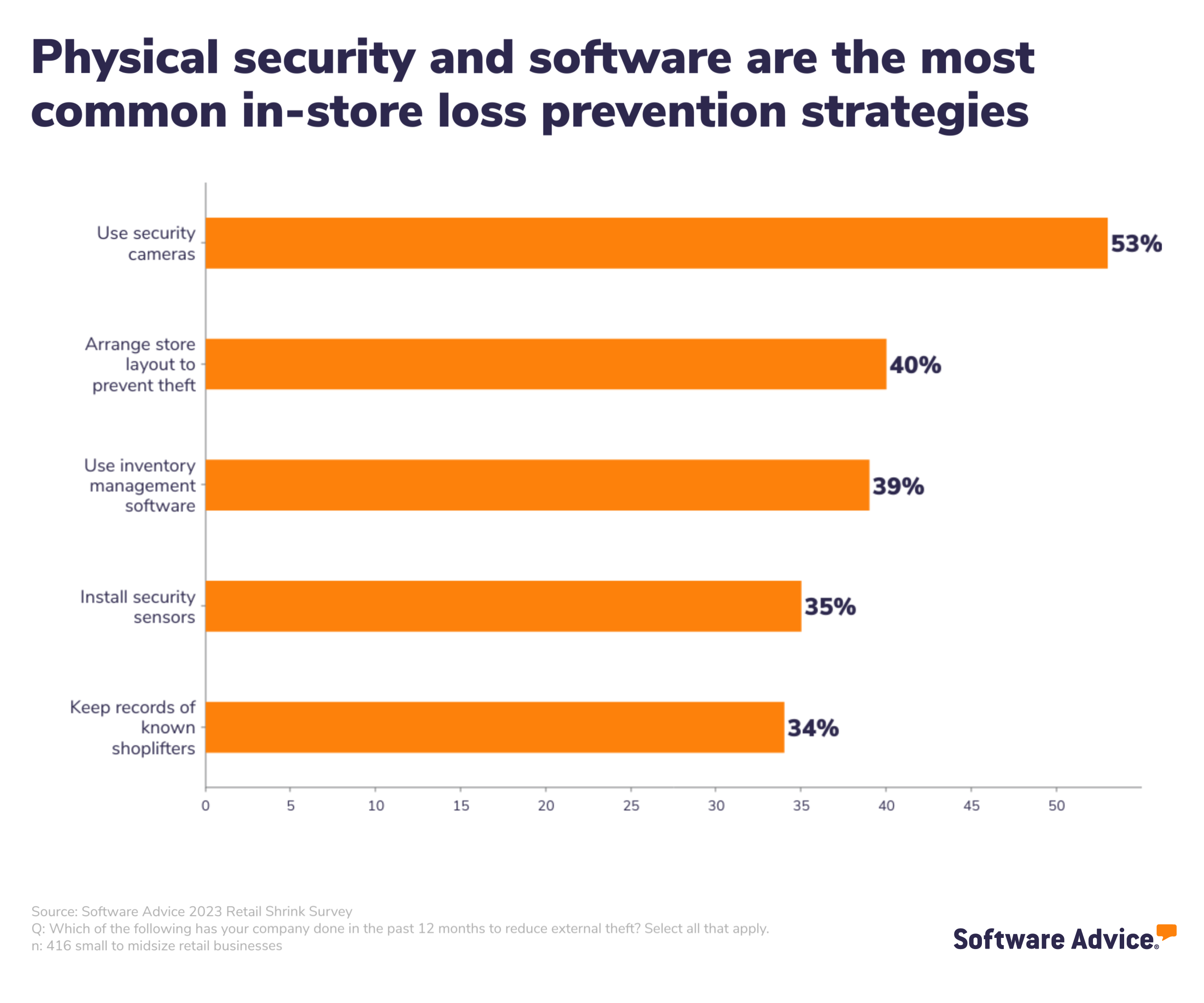
Use software to your advantage
Your inventory management and accounting processes may be due for a tech update. Software that is difficult to use or has poor integration with other systems isn’t just a headache—it’s also a breeding ground for errors that can contribute to shrink.
Consider upgrading or purchasing new software to better handle your business, especially as it grows. And make sure your employees know how to use it. You can start by exploring point of sale systems, inventory management software, and business intelligence software.
Another route to explore is IoT physical security, including cloud-based surveillance camera software that can automatically collect data on customers, help employees monitor incidents, and help you take action after an alarm is triggered.
Minimize the impact on customer experience
At the end of the day, customers come to your store either to make a quick and convenient purchase or to enjoy the sensory experience of browsing. Some anti-theft tactics, such as locking products in protective boxes or keeping a lot of products behind the register adds friction that could drive customers away.
Customers want to feel like welcome guests in your store, not like incident reports waiting to happen. Similarly, your employees want to help customers without putting themselves in unsafe situations. Do your best to ensure positive experiences for both while protecting your bottom line.
Treat your employees like they matter
Your employees are your first line of defense against shrink. Providing comprehensive training, paying competitively for fair hours, and recognizing hard work encourages your employees to take ownership in preventing shrink.
Set reasonable expectations about how much your employees should do to prevent external theft. Trying to stop a determined shoplifter can be dangerous, but there are other preventive measures employees can take before theft has a chance to happen.
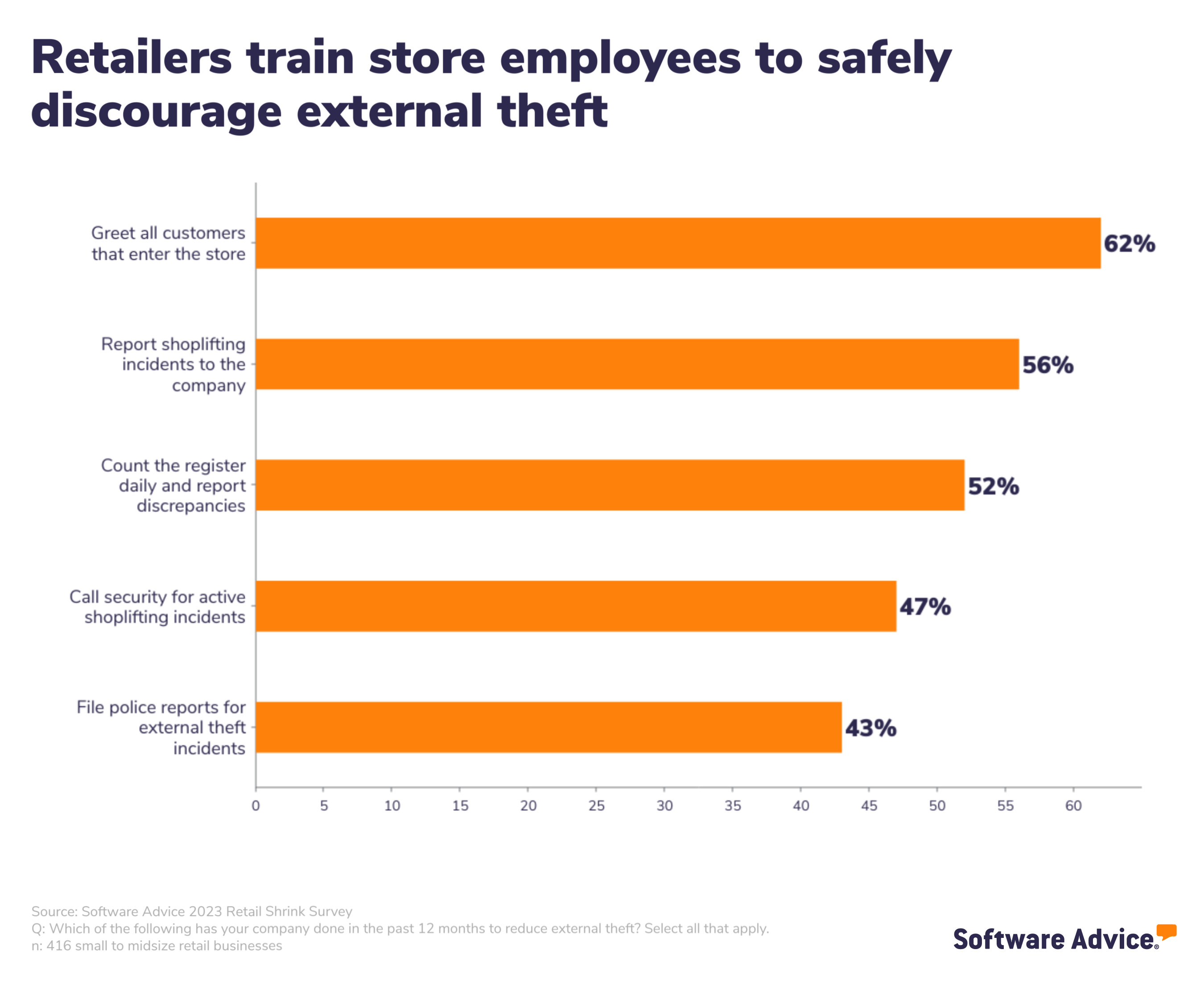
Reduce shrink the right way
If your company is experiencing more shrink than in previous years, you’re not alone. There may be more going on beneath the numbers, so it’s important to take the time to examine why and how you’re incurring more losses, rather than quickly move ahead with a strategy that could alienate customers and employees.
Finding the right software can help you identify the root causes of shrink at your business, as well as prevent it in the future. If you’re not sure where to start, try chatting one-on-one with an advisor from Software Advice for free to get personalized help and recommendations.
Sources
Target expects organized retail crime-fueled losses to jump by $500 million this year, CNBC
NRF Reports Retail Shrink Nearly a $100B Problem, National Retail Federation
Shrink and theft losses near $1 billion at Lowe’s — here’s how much they’re costing other retailers, CNBC
Retail Group Retracts Startling Claim About ‘Organized’ Shoplifting, The New York Times
California targets smash-and-grabs with $267 million program aimed at ‘brazen’ store thefts, The Associated Press
Survey methodology
*Software Advice's 2023 Retail Shrink Preparations Survey was conducted in November 2023 among 416 professionals representing small to midsize retail businesses with management roles or above. Respondents were asked about the incidence of retail shrink at their company, including external theft, employee theft, vendor/supplier fraud or errors, accounting errors, and damaged items. They were also asked about their company's response to and prevention methods against shrink. Respondents were screened for companies with 10,000 or fewer employees. Businesses that sell vehicles or software were excluded.